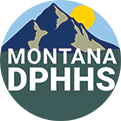FOR IMMEDIATE RELEASE
Date: June 10 2025
Contact:
Madison McGeffers, Public Information Officer, Montana Department of Environmental Quality, (406) 444-6360
madison.mcgeffers@mt.gov
Contact: Jon Ebelt, Communications Director , DPHHS, (406) 444-0936, (406) 461-3757
jebelt@mt.gov
Look Out for Harmful Algal Blooms When Recreating this Summer
HELENA—When recreating on Montana’s waterbodies, be on the lookout for harmful algal blooms (HABs) that can occur on Montana’s lakes and reservoirs. HABs can release toxins that can harm human and animal health. Report suspected HABs at HAB.mt.gov to help alert others and prevent illness.
HABs can occur when certain conditions (such as nutrient pollution, sunlight and temperature) cause a rapid overgrowth of blue-green algae, also called cyanobacteria. Blue-green algae are native organisms and commonly occur at low, safe densities in Montana’s lakes, streams and reservoirs. Blue-green algae are often confused with green algae since both can produce overgrowths (blooms) that affect recreation, cause odor issues and reduce oxygen in the water. However, green algae do not produce harmful toxins.
How to identify a HAB:
- A coloration or scum in the water that can look like spilled paint, pea soup or grass clippings.
- Often blue, green or red in color.
Toxins can be produced at any time when a bloom is present and remain in the water even after the bloom has visually dissipated. Toxins in the water may cause irritation of the skin and eyes upon contact; irritation of the respiratory system if water droplets are inhaled; and headache, nausea and vomiting if ingested. Pets and livestock can become severely ill and even die if they ingest the toxins. HABs do not always release toxins.
When in doubt, stay out. If the water shows signs of a HAB, do not drink, swallow or swim in the water and keep children, pets and livestock out. Rinse off with tap water immediately if you think you or a pet has come in contact with a HAB. If you suspect a HAB-related illness in a person or animal, call your health care provider or veterinarian, or if it is an emergency, call Poison Control immediately at 1-800-222-1222.
Nutrients like nitrogen and phosphorus fuel algae growth and potential HABs. Actions you can take to reduce nutrient pollution in Montana’s waters include:
- Reduce your use of lawn or crop fertilizers.
- Landscape with native plants that don’t need fertilizers.
- If you live alongside a stream or lake, restore and protect native woody vegetation, plants and grasses because they help filter pollution and stabilize land.
- If your home relies on a septic system, have it regularly serviced and consider upgrading it to a higher-level treatment system.
The Montana Department of Environmental Quality (DEQ) and Department of Public Health and Human Services (DPHHS) maintain HAB.mt.gov , a website where people can submit and view reports of suspected HABs. State agencies will work with the local jurisdiction to evaluate and monitor the incident.
DEQ will post confirmed HABs at HAB.mt.gov and on Facebook throughout the summer. Follow @MTDEQ for updates. Recreationalists may check the website to view the map of reported blooms, health advisories, information associated with reports and information on how to identify a HAB.
About DEQ:
At the Montana Department of Environmental Quality, our mission is to champion a healthy environment for a thriving Montana. DEQ is charged with maintaining and improving Montana’s air, land and water. Please visit deq.mt.gov for more information about DEQ programs.
About DPHHS:
The Montana Department of Public Health and Human Services serves Montanans in their communities to improve health, safety, well-being, and empower independence. For more information, please visit dphhs.mt.gov.

